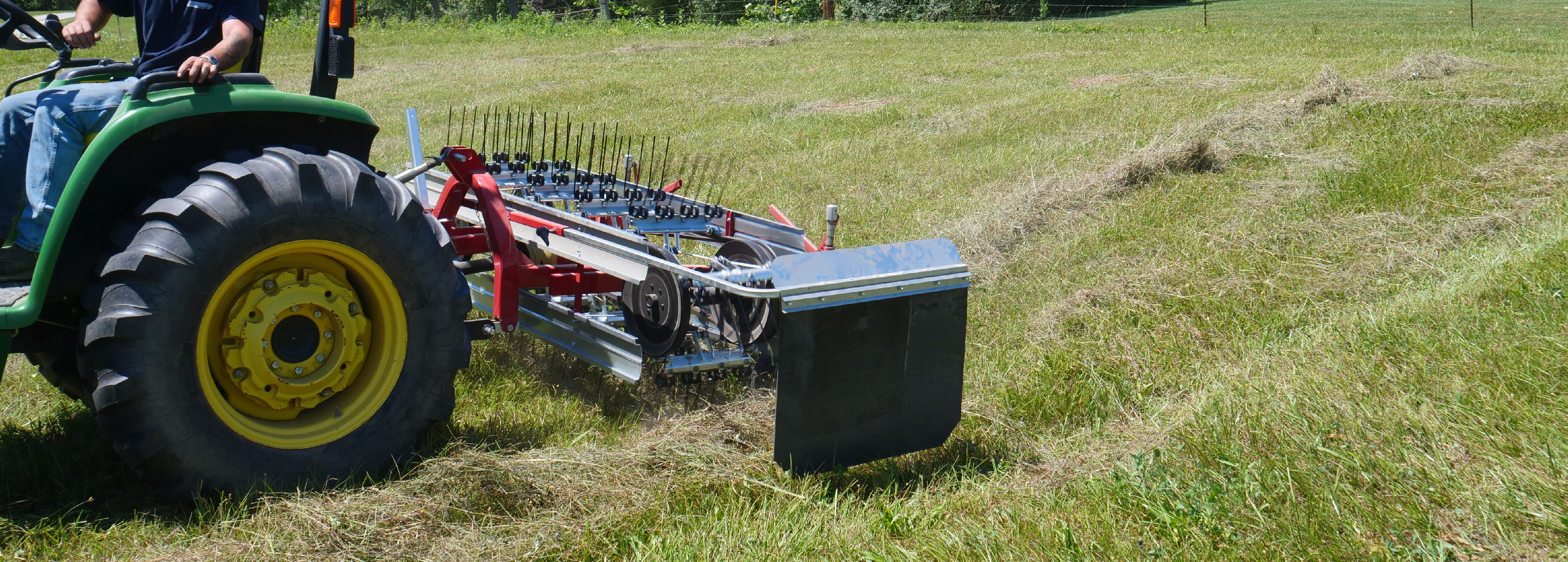Tedding? Raking? What's the Difference?

Small-farm operators who are new to hay production are often unsure of the differences between tedding and raking when it comes to baling hay. They confuse the two processes thinking they are one and the same and/or that the same implements can be used to perform both tasks. Let’s discuss this here.
Tedding is the act of fluffing and spreading cut forage to increase air and sun exposure and decrease drying time. Tedding is typically done after the hay is mowed and before it is raked into windrows for baling. Most tedders use a rotary motion to grab the hay with spinning tines and cast it out the back of the machine.
Raking is the process of turning hay one final time and forming the windrows necessary for baling. Raking is the next-to-the-last step in the baling process and is done just before the baler is brought into the field. While the act of raking does turn the hay and allow the underside to reach more sunlight, this is not its primary purpose. Raking forms the hay into tighter, narrower swaths that can be more easily forked up by the baler.
Simply put, tedding spreads and fluffs the hay for drying. Raking gathers the hay into windrows for efficient baler pickup. And as you probably guessed, different implements perform these different tasks–tedders or rakes. There is an exception, however, which definitely deserves consideration–the belt rake.
Here at Tractor Tools Direct, we carry the Ibex TS110 2 Basket Tedder. Basket tedders lift and turn the mown hay and spread it out. This action speeds drying and dissipates heat, sealing in nutrients as the hay cures and ensuring that mold and bacteria do not develop. The TS110 Tedder is lightweight, efficient, and easy to use. It does not use hydraulics, and only requires a minimum of 15 PTO HP to operate. Just connect the drawbar, attach the PTO shaft, and start tedding.
As for raking, TTD offers both wheel rake and belt rake options. Wheel rakes are the most economical choice for raking hay and their design matches their name – large wheels made up of tines rotate vertically to rake up forage. With few moving parts they are mechanically simple and require very modest horsepower. There are no requirements for a PTO or hydraulics on your tractor. The rake is driven by contact with the crop being raked and the forward motion of your tractor.
Belt rakes, however, are 2-in-1 machines serving as both a tedder and a rake. A belt rake also has a design that matches its name – a belt with tines attached rotates and rakes up forage. In less than 30 seconds and without tools, an Ibex belt rake easily converts to a tedder with just the removal of a hay stop. A belt rake’s low-profile design means you can rake in places often considered too confined for conventional tractor-driven rakes and makes them efficient to store. Connection is a breeze, and once connected, raking height can be quickly adjusted by levers on the pneumatic wheels. The width of the windrow is adjustable, making it easy to match your windrow size to your baler.
More information, including raking/tedding patterns and the best timing of these processes, can be found in our blog or in TTD’s exclusive handbook “Haying Independence: The Ultimate Guide to Small-Farm Hay Production”. You can also visit our website, or give us a call at 260-BALE-HAY! Happy Haying!
Recent Posts
-
Boost Pine Straw Production Efficiency with Ibex Mini Round Balers
At Tractor Tools Direct, we're known for our high-quality hay equipment tailored for small farms …Dec 8th 2025 -
How to Winterize Your Tractor: Essential Maintenance Tips to Protect Your Investment
Farm equipment is one of the most valuable investments a farmer can make. At Tractor Tools Direc …Dec 1st 2025 -
Farm Tax ID Explained: Benefits, Eligibility, and How to Apply
As the end of the financial year approaches, it's a great time for small farmer operators to rev …Nov 12th 2025




